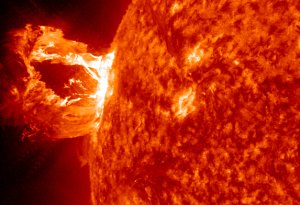
A beautiful prominence eruption shot off the east limb (left side) of the sun on Monday, April 16, 2012. …
One family is going to the extreme to prepare for such a contingency, building a castle here in the Carolina mountains where they could hole up without electricity and fend for themselves for months or years. The family is the subject of a new show on the National Geographic Channel called "Doomsday Castle," which premiers tonight (Aug. 13) at 10 o'clock ET.
But how likely is such a scenario?
The nuke scenario
It depends on whom you ask. One way to create a widespread and damaging electromagnetic pulse (EMP) would be to detonate a large nuclear weapon over the central United States, at an altitude of 25 miles to 500 miles (40 kilometers to 800 kilometers), according to the Commission to Assess the Threat to the U.S. from EMP Attack, in testimony before the House Armed Services Committee in July 2008. At this height, a nuclear blast could interact with the ionosphere, the shell of electrons and electrically charged particles surrounding Earth, to create a series of electromagnetic pulses that could reach across a continent, according to the commission. [Photos: Inside the Doomsday Castle]
Once a burst of atmospheric radiation hits the ground, it could induce strong currents in telephone and electrical cables, which can short out transformers, said Daniel Baker, a physicist at the University of Colorado. Transformers take high voltage current and "transform" it into low voltage current that can be used by households. But an EMP could derail this process, creating currents that overheat transformers and cause them to fail, Baker said.
Brent, the patriarch of the "Doomsday Castle" clan, thinks that terrorists or a rogue nation could loft a nuke high enough to take out the electricity grid over the eastern United States or Southeast, he told LiveScience. (Family members aren't disclosing their last name or location for fear of curious and/or hostile fans showing up on their castle steps.)
But such a nuclear attack would be nigh suicidal for any country, as the United States could retaliate with its nuclear submarines, which lurk in the oceans around the world out of the range of any EMP threat, according to the commission. It's also hard to imagine that a rogue terror group could accomplish such a feat, due the technical difficulty of the task. And in either case, the missile would have to make it into the middle of the country, eluding U.S. missile defenses, according to a fact sheet from the Department of Homeland Security.
Solar flares
An electromagnetic surge from a solar storm is a more likely threat for an EMP. Generally, experts expect a bad solar storm to reach Earth about once every century, Baker said. The last time one hit the planet was during the Carrington event, when particles from a powerful coronal mass ejection overloaded telegraph wires and set paper messages on fire in 1859. A coronal mass ejection is an enormous sun eruption of super-hot plasma that spews charged particles across the solar system.
At that time, the world was just beginning to use widespread electronic communications. Baker and his colleagues just submitted a paper that details a coronal mass ejection that took place in July 2012. In that event, some 80 billion pounds of energized particles were ejected from the sun at a speed of several million miles per hour. Luckily it missed Earth. But if it had occurred one week earlier, it would have been aimed directly toward our planet — with catastrophic results. [The Worst Solar Storms in History]
"Given our current state of readiness, we'd still be picking up the pieces," Baker said.
Bad solar storms work by sending "blobs" of energized particles toward the Earth, carrying their own magnetic field, Baker said. This missile-like group of particles can "open a gate" in Earth's magnetic field, allowing energetic particles to enter the high atmosphere and send currents all the way down to the planet's surface, he said. These can induce currents in the electrical grid, overheating transformers and causing them to fail. And these things can take months or years to replace. "You can't exactly buy another at Sears," Baker said.
Preparation and protection
There are ways to protect against an EMP attack or a solar storm, although they involve coating certain electrical parts and allowing electrical current to be routed around transformers, Baker said — steps that would be expensive, he said. Installing extra transmission lines and generators could help divert power around vulnerable nodes in the grid, he added.
One way to protect devices is to encase them in Faraday cages, wherein a shell of conductive material prevents them from experiencing external electromagnetic currents. The military protects some of its most important facilities this way, Brent said.
While some preppers take things a little far, both an EMP attack and control mass ejection are "genuine concerns," Baker said. "I don't think taking preparations for both is unwarranted" by governments and individuals, he said. Governments can prepare by looking at how to better secure the electrical grid, Baker said. Some reasonable preparations individuals can take involve keeping enough food and water to last a week or more, he added.


No comments:
Post a Comment